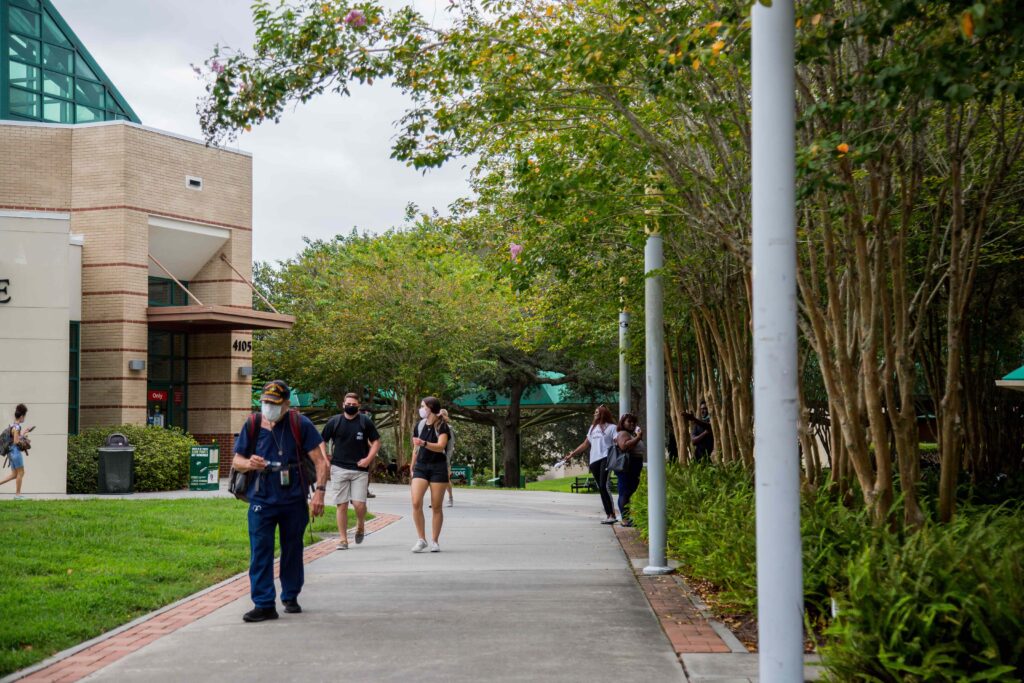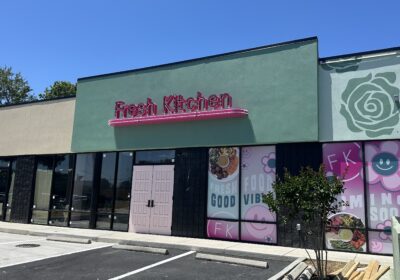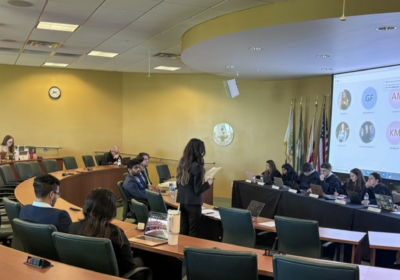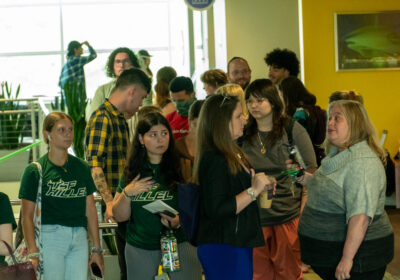Admissions, enrollment rise as USF prepares for pre-COVID-19 semesters

As USF prepares to return to pre-COVID-19 operations, an increase in the total number of admission and enrollment numbers show positive trends despite the challenges posed by the pandemic.
The university has processed over 75,000 undergraduate and graduate applications for the summer and fall 2021 semesters as of May 10, an increase of 23.9% from 2020. Out of the total number of applications processed, 34,731 undergraduate and graduate students were admitted, increasing 26.2% from the number of students admitted in 2020.
“We didn’t quite know where we were going with this, as you might imagine, given the constant swirling uncertainties associated with COVID-19 over the past year,” Provost Ralph Wilcox said during Tuesday’s Board of Trustees meeting. “It was unclear just how future students might respond to changes across the higher education landscape.”
The number of students admitted, however, does not represent the number of students enrolled, according to Wilcox. Some students admitted might choose to attend other universities, and they are only considered enrolled once they submit a monetary deposit in order to secure their spot in the incoming class.
For the class of 2025, a total of 6,880 first-time-in-college (FTIC) students have submitted a deposit as of May 10, an increase of nearly 16% over the 5,946 students who submitted deposits in 2020, according to Wilcox.
The university has also been working toward meeting certain targets that have been a focus of attention across campus, including the increase in St. Pete’s enrollment as well as the increase of Black students in the summer and fall semesters entering the FTIC class.
Out of the 6,880 FTIC students who have submitted deposits, 457 are Black and 1,410 are Hispanic, compared to 398 and 1,314, respectively, in 2020.
The St. Pete campus alone experienced a spike of 87.9% in its total number of FTIC enrolled students compared to last year’s numbers. As of May 10, 795 FTIC students have submitted a deposit compared to 423 in 2020.
Among the 795 FTIC students enrolled at St. Pete, 48 are Black and 183 are Hispanic students, an increase of 166.7% and 174.1%, respectively. Only 18 Black and 87 Hispanic students committed to USF for the summer and fall semesters in 2020.
While the numbers of enrolled students are high, Wilcox said the number might be impacted throughout the summer as some students tend to change their minds and choose other institutions.
“I will caution you at the end of the day, when August 23 comes around, it’s unlikely that 795 new freshmen will have been rolled on the St. Petersburg campus in summer and fall,” Wilcox said.
“We face a phenomenon that is known across the admissions community as ‘melt in the summer.’ That effectively means that we will witness some attrition of that number of students pick up opportunities, change their decisions at the last moment and enroll at other institutions. There are many factors that are at work here.”
Wilcox, however, said he doesn’t expect the number dropping significantly below 700. He said he’s confident the university will exceed the goal of increasing the number, as well as the diversity, of students enrolled at the St. Pete campus.
Following the same trend as FTIC numbers, the total number of admitted transfer students has also increased in comparison to summer and fall 2020.
This year, the university admitted 5,805 transfer students, an increase of 16.3% compared to 2020. Out of the total admits, 742 are Black and 1,283 are Hispanic students, an increase of 26.6% and 14.1%, respectively.
The university continues to strengthen its efforts to return to pre-COVID-19 operations June 28, the start of the Summer B semester. Among its goals, the university is working toward offering face-to-face classes at full capacity, mirroring a model offered in fall 2019.
When it comes to class sections by modality, the university is planning to offer 77% of traditional classroom, face-to-face instruction in the upcoming fall semester across all three campuses, an increase compared to fall 2020, during which only 29% of the total number of classes were offered in person. In fall 2019, 81% of classes were offered in person.
The number of hybrid classes will decrease starting in the fall semester, with only 4% of classes being offered in that modality compared to 20% in fall 2020. The number of all distance, fully online classes will also decrease compared to last fall, however, it will mirror the same percentage of classes offered in fall 2019, at around 18%. In fall 2020, due to the pandemic, around 48% of classes were offered primarily online.
The maximum seat count offered in fall 2021 will also mirror fall 2019 numbers, with face-to-face classrooms holding a 65% capacity. In the fall 2020 semester, class capacities for face-to-face instruction were limited to 17%.
While there was an increase in admissions and enrollment, the average GPA and SAT scores have been slightly affected as a result of the pandemic and the drop in the number of times each student took the test compared to years past. Overall, the incoming class averaged a 4.15 GPA and an SAT score of 1295, a decrease of 0.03 and 17 points from fall 2020, respectively, according to Wilcox.
The St. Pete campus also marked a historic accomplishment, as five National Merit Scholars submitted an enrollment deposit to secure their spot as Bulls. The Tampa campus received 57 deposits from National Merit Scholars.
“As you can see, we have 62 already confirmed, we’re working hard on the other five,” Wilcox said.
“They come to us from 17 different states and the university and state of Florida, including a one from a military family on an army base in Japan. So again, very excited from California to Massachusetts to Michigan, New York, Pennsylvania, Wisconsin and beyond. We look forward to welcoming the largest number of National Merit Scholars in the history of the University of South Florida.”
The Judy Genshaft Honors College experienced a slight decrease in the overall number of enrollment deposits, with 886 of deposits received across all three campuses as of May 10 compared to 867 in 2020. Out of the total number of deposits, 798 enrolled in Tampa, 78 in St. Pete and 10 in Sarasota-Manatee.
The university is still finalizing its plans to isolate students who test positive for COVID-19 on its on-campus isolation spaces across the Tampa and St. Pete campuses. In the 2020-21 academic year, positive cases were isolated in the Cypress Suites residence halls at the Tampa campus and in Ibis Hall at the St. Pete campus.
After a challenging year in housing occupancy, Housing and Residential Education is finally filling up its dorms across all three campuses.
The Tampa campus received a total of 5,464 applications, out of which 4,101 were assigned a room. Assistant Vice President of Housing and Residential Education Ana Hernandez said the Tampa numbers are 17% higher than last year, with about 3,566 and 3,731 residents for the fall 2020 and spring 2021 semesters, respectively.
She also added that an additional 1,500 students have active applications on the Housing Portal and are yet to select their room assignments.
The St. Pete campus experienced an 88% increase in the number of FTIC applications, with 583 in total. Out of the number of applications submitted, 454 have been assigned a room for the 2021-22 academic year so far.
For the 2021 summer semester, a total of 680 students will be living at the Tampa campus compared to 62 in 2020 and 1,656 in 2019.
“If we stopped assigning people today, we would be 52% ahead of where we were last year at the end of last year. So the occupancy certainly is taking an uptick,” Hernandez said.
The trends, according to Wilcox, remain positive as the university receives more applications and deposits from students set to begin their college career at USF.
“Again, [the numbers are] trending in the right direction,” Wilcox said. “Still a lot of work to do, I think we were, quite frankly, trying to figure out student behavior because it is different than in years past. And we are going to continue to work to meet their priorities.”






